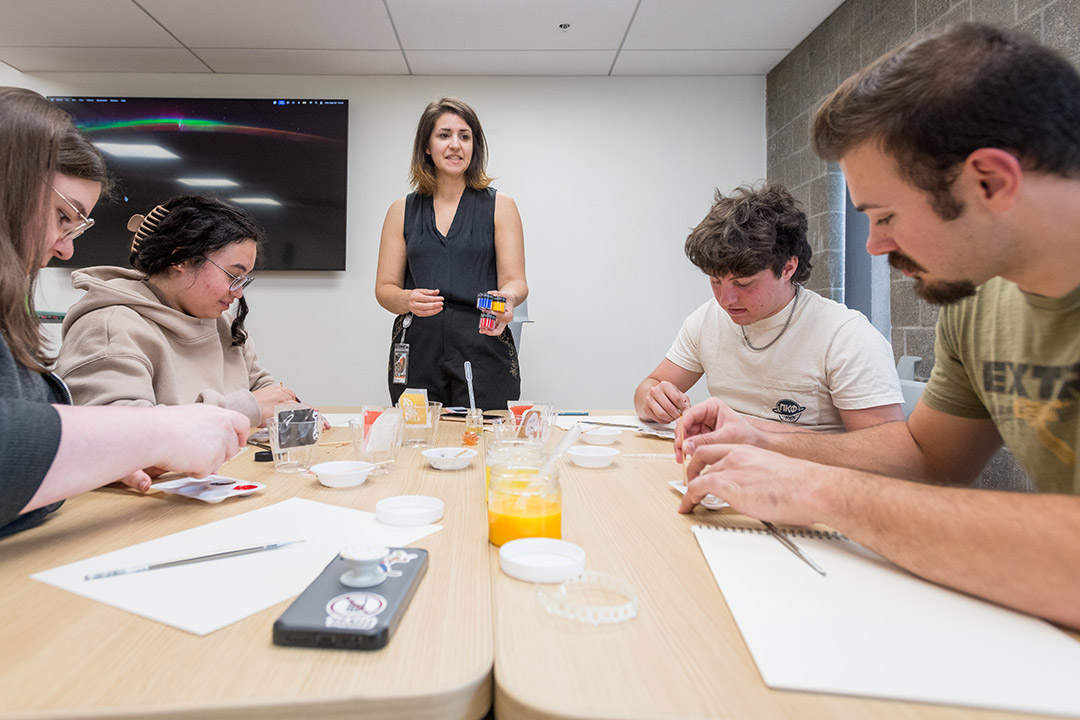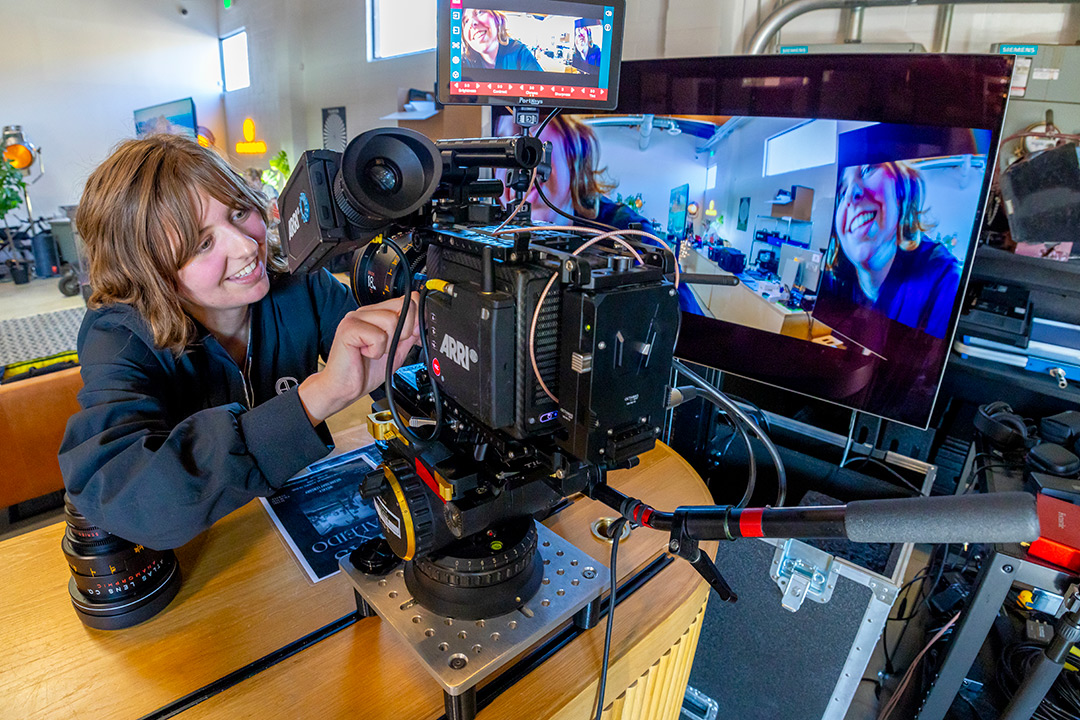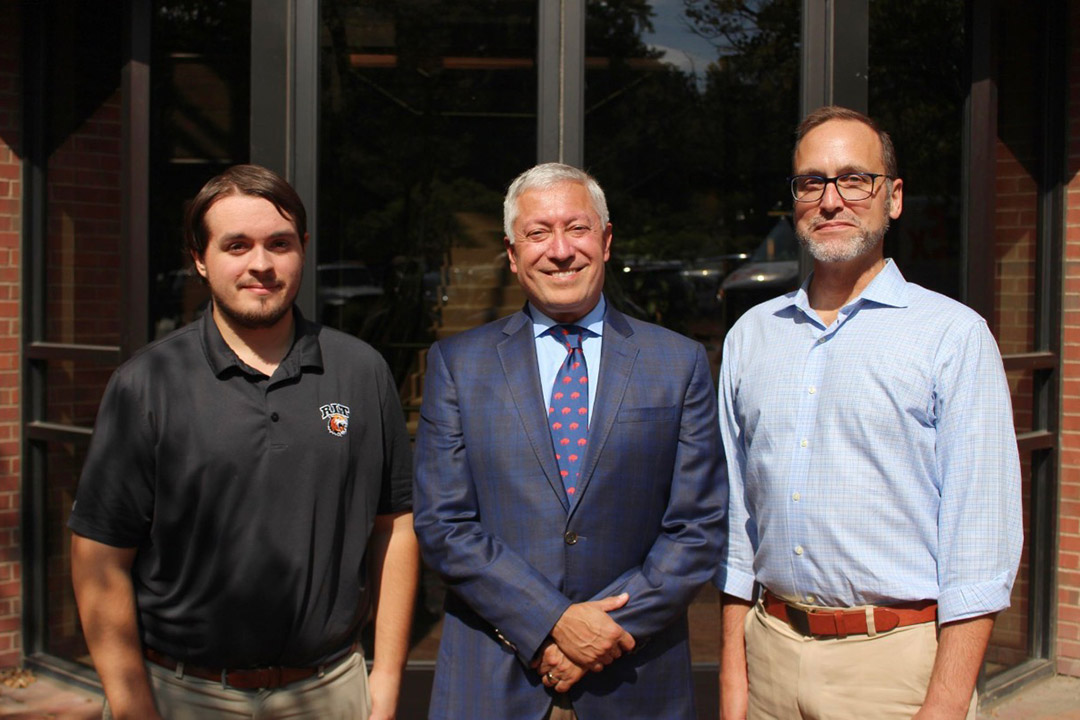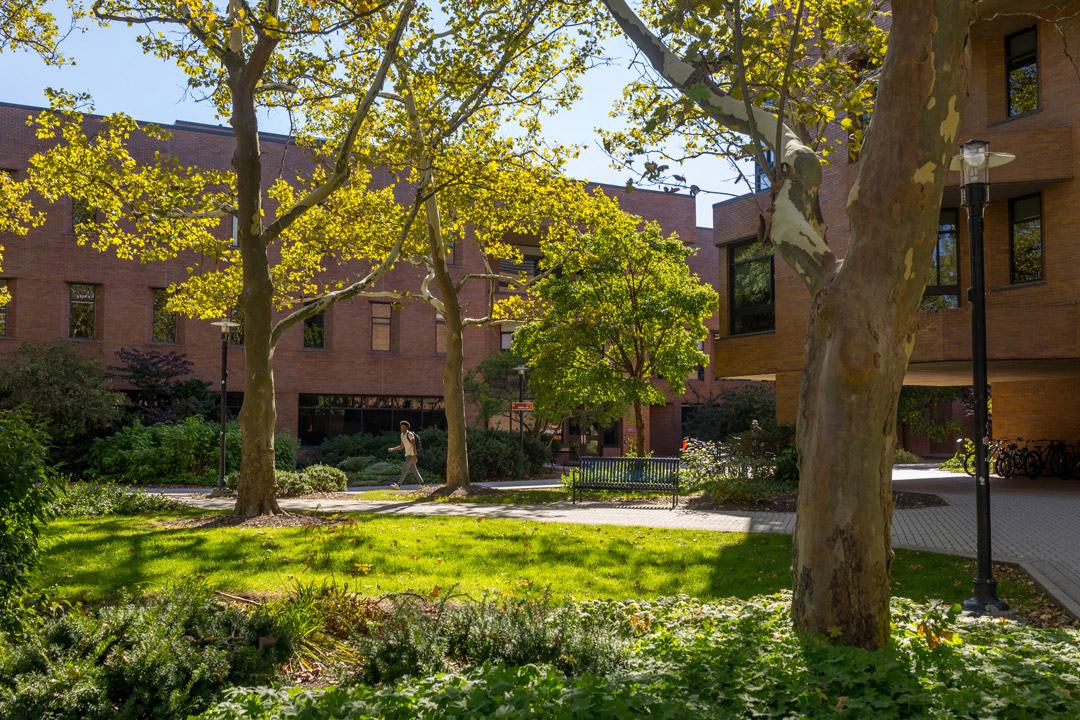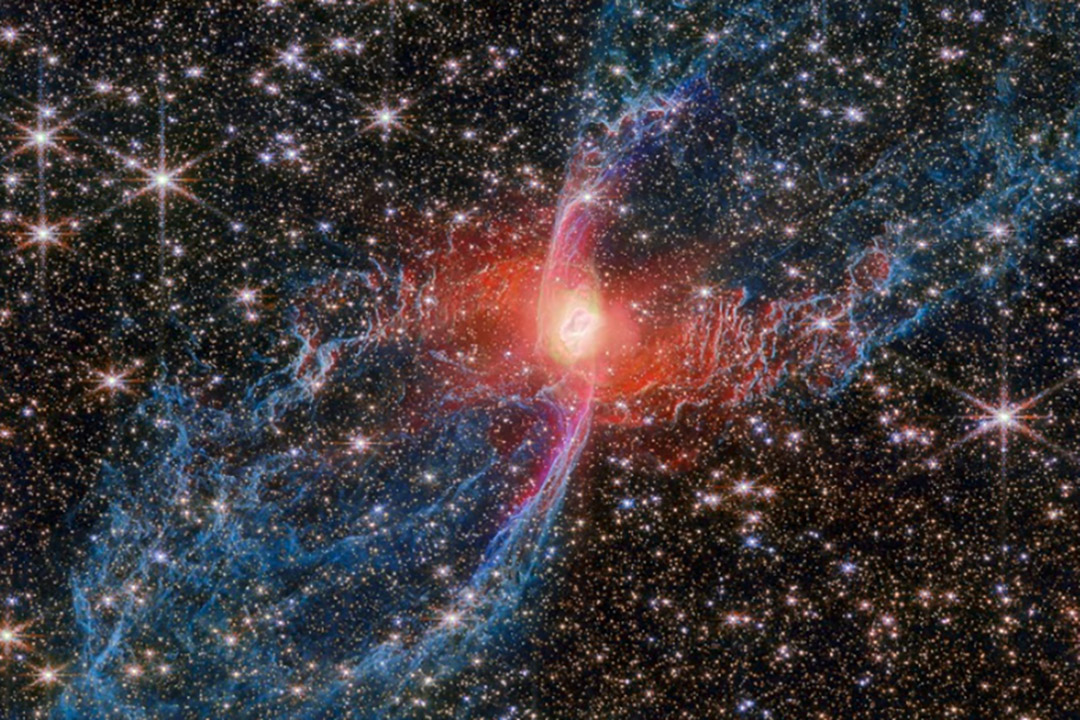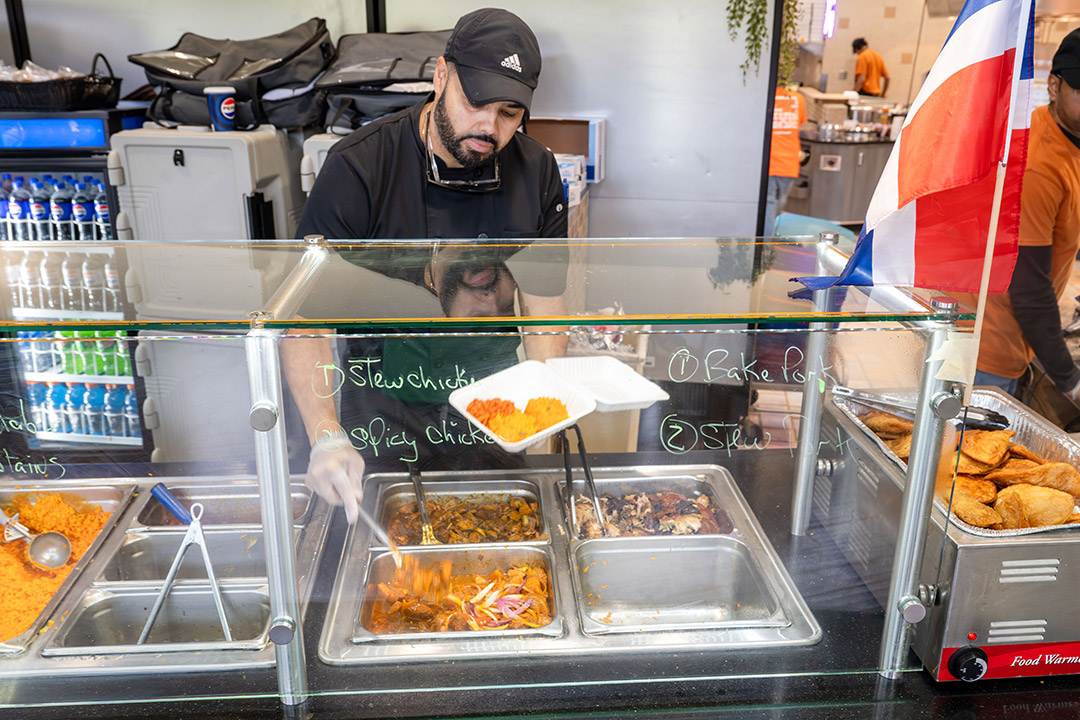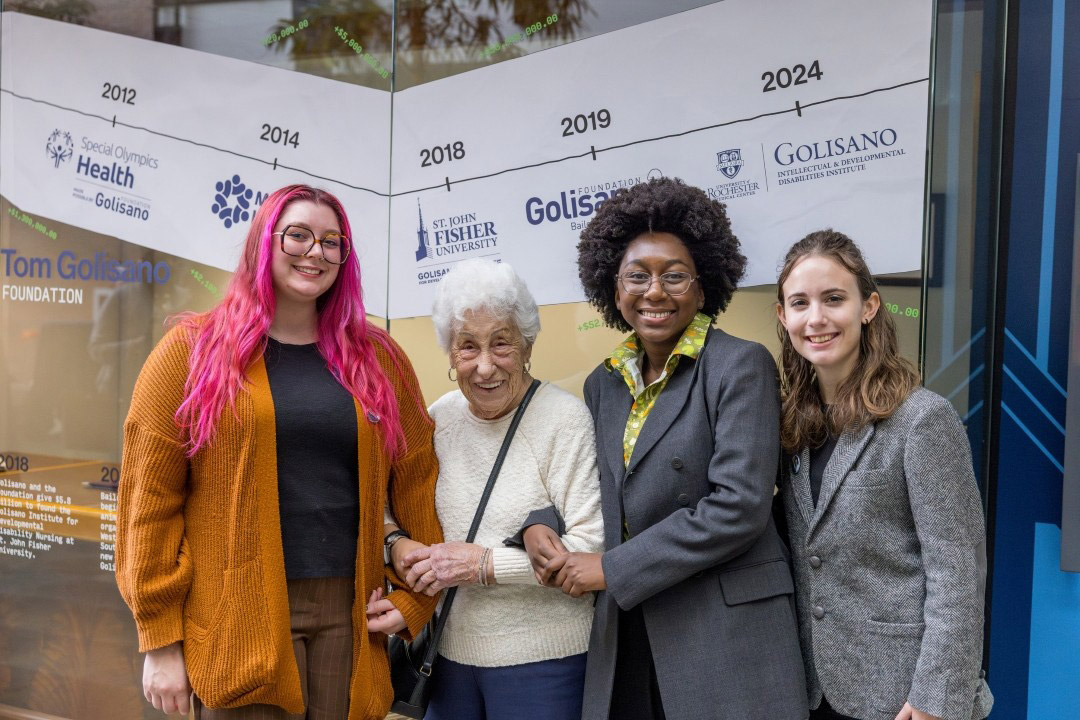Ph.D. candidate encourages her class to judge a book by its cover
As a professional paper conservator and color science Ph.D. candidate, Leah Humenuck has studied books from every angle and wavelength.
This semester, Humenuck is sharing her love for paper, ink, pigments, and all the material components of a book, in her course, The Secret Lives of Books, a special topics elective offered by the museum studies program in the College of Liberal Arts. She is gaining hands-on experience from the other side of the classroom, working with undergraduate students, sampling an academic career, and adding to her résumé.
While the evolution of the book has been a global accomplishment, Humenuck focuses on book development in the Western world and the influence of parchment, which shaped the form, Gutenberg’s game-changing printing press, and the rise of paper.
Her class teaches students how to assess a book through its materials and construction. Trends in book development point to available materials and choices often based in practicalities, she said.
“There’s more than one way to read a book,” Humenuck said.
She alternates her lectures with lab experiences that focus on handling rare books, mixing pigments, learning about book storage, and papermaking.
“I think the best way to interact with history is to do the history,” Humenuck added.
Christis Shepard, a fourth-year museum studies major from Bayonne, N.J., is enjoying the deep dive into the history of making books.
“We’re currently learning about medieval books, the inks medieval scribes and artisans used, and the techniques used in creating parchment,” Shepard said. “It makes me appreciate the ease we have today in making books and that many of these old books managed to survive into the modern day.”
Humenuck’s class meets in Wallace Library and frequently visits the Cary Graphic Arts Collection, RIT’s special collection of rare books, and graphic design and printing history.
“I wanted to create a class that would intersect with the Cary Collection,” Humenuck said. “I tell my students, ‘While you’re here, use the Cary Collection because it’s phenomenal.’”
Humenuck developed the special topics class at the suggestion of Juilee Decker, director of museum studies and co-director of the Cultural Heritage Imaging lab. Decker knew of Humenuck’s interest in an academic career.
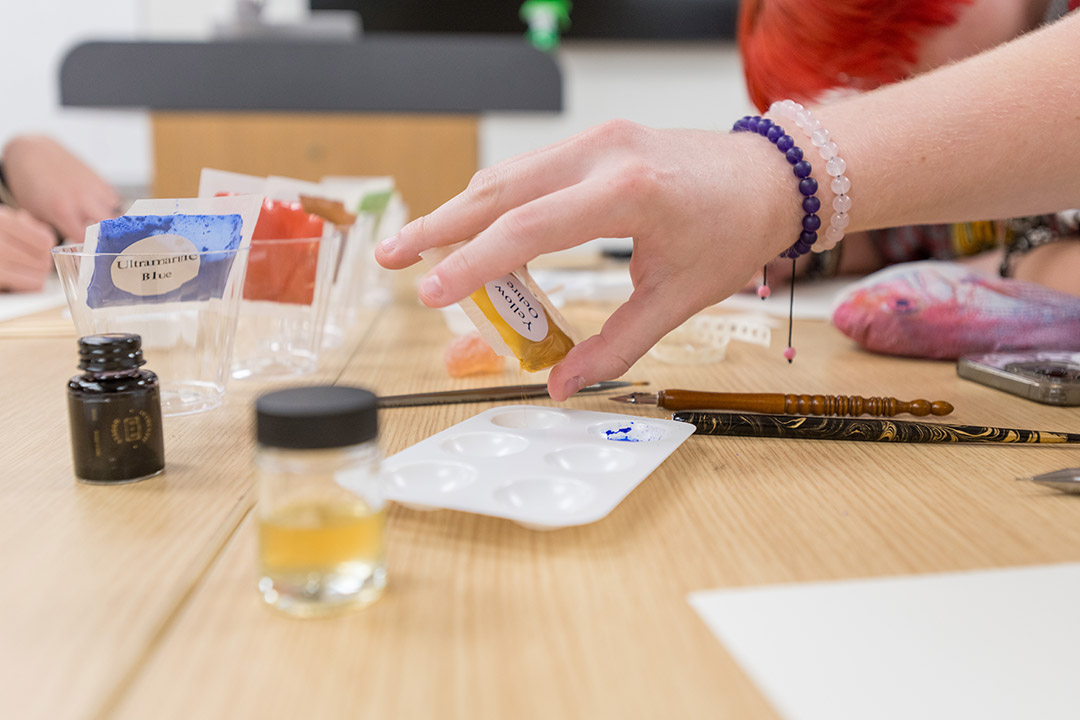
Liam Myerow
A student in the Secret Lives of Books course creates pigments in a medieval method by combining the powdered pigment with a binder in the glass jar.
“I enjoy tapping into what students are doing at the graduate level and seeing how they might inform what we’re doing in museum studies,” Decker said. “I thought that Leah’s expertise as a book and paper conservator would provide a materials perspective on a topic that is related to museum studies.”
With a focus on libraries, archives, and museums, and a tech-infused approach to liberal arts and sciences, RIT’s museum studies program is one of the few undergraduate degree programs of its kind in the United States, Decker added. Interdisciplinary in nature, the program draws upon expertise from multiple colleges and divisions with a book niche.
Steven Galbraith, curator of the Cary Graphic Arts Collection, teaches a course about the history of the book from a curatorial perspective, and faculty at the Image Permanence Institute offer a course about preservation and collections care.
“Leah has served as a mentor and an internship supervisor for a number of my students,” Decker said. “I work with her in a research capacity, so I am aware of her excellent scholarship ethics and her keen eye toward mentoring and developing lifelong learning goals for people.”
The path to becoming a college instructor is different for every Ph.D. student.
The Secret Lives of Books is Humenuck’s first experience writing a syllabus and planning a curriculum for a semester-long class.
Decker gave her guidance about classroom parameters and syllabi. She has also sat in on Humenuck’s classes.
“It’s common that there’s not a precursor to teaching,” Decker said, reflecting on her doctoral degree at Case Western University. “There isn’t a formal class that says, ‘This is how you become an instructor now that you want to share your knowledge of this topic.’”
The opportunity to teach builds upon Humenuck’s experience gained through her many guest lectures and talks, conference presentations, an internship program she created for museum studies, and her semester as a graduate teaching assistant for the Fundamentals of Color Science course.
Christie Leone, assistant dean of the RIT Graduate School, said there are a lot of opportunities for graduate students to gain hands-on teaching experience by working as graduate teaching assistants under the supervision of a faculty mentor.
Graduate teaching assistants are required to take a training course, GTA Foundations, offered by the Graduate School in collaboration with the Center for Teaching and Learning. The class provides basic background information and introduction to the responsibilities of a graduate teaching assistant at RIT. In addition, some colleges and departments offer their own training specific to their discipline.
Humenuck’s class is giving her a multidisciplinary teaching experience. The elective has drawn 17 students from a variety of majors and with different opinions on materials for preserving information.
“Being able to answer questions and pull a class together with students having different perspectives is something I really enjoy,” Humenuck said.
Latest All News
- ‘TheWrap’ recognizes RIT as one of the nation’s top film schoolsForward-thinking faculty, curriculum that fuses technology, the arts, and design, and a legacy of priming students with a maker mentality helped RIT’s School of Film and Animation (SOFA) maintain its place on TheWrap’s list of Top 50 Film Schools of 2025. This year, RIT ranked 32nd on the list. “We are very excited to have been ranked again by TheWrap. This is evidence of the amazing work our students and faculty are doing every day. The interactions and collaborations between our live action, animation, and motion picture science students prepare all of them for the challenges and opportunities brought by what is probably the most dynamic time in our industry,” said Ricky Figueroa, SOFA director and John Traver Professor. Over the last year, the film and animation school increased its reputation in Hollywood, earning recognition from publications like Variety, The Hollywood Reporter, and Animation Career Review in addition to TheWrap. When granting this year’s rank, TheWrap stated that RIT is well positioned to help students in the era of rapid technological change ushered in by digital tools and AI. The publication also noted that the university is at the forefront of these trends and puts industry-standard tools into the hands of students, citing facilities like MAGIC Spell Studios as evidence of RIT’s dedication to the fusion of creativity and technology. “The School of Film and Animation is the perfect example of RIT’s mission to utilize technology, the arts, and design to change the world. Recognitions like this affirm we are on the right track,” said Figueroa. Immersive and creatively challenging programs like RIT in LA and the new student exchange program with the Film and TV School of the Academy of Performing Arts in Prague (FAMU) offer opportunities for students to exercise their skills outside of the classroom. Experiential learning opportunities like these contribute to RIT’s legacy of nurturing a “maker” mentality in students. TheWrap stated that this legacy is evident when considering the outcomes of alumni like Alex Forsythe, senior director of science and tech at the Academy of Motion Picture Arts and Sciences; John Traver, Frame.io co-founder and creative technologist; and cinematographer Michael Slovis. Go to RIT’s School of Film and Animation website to learn more about its program offerings.
- Co-op student applies tech skills to the startup finance worldBen McManus, a fifth-year computer science student from Denver, is gaining firsthand experience in automation and IT in his co-op at Indivisible Partners, a national startup finance company co-founded by RIT alumnus and former Merrill Lynch executive Alok Kapoor ’93 (computer science). How did you first connect with Indivisible Partners? It actually came through my fraternity, Kappa Delta Rho. Alok Kapoor, one of our alumni, came to one of our formals and mentioned he was looking for students with tech experience. Our president connected us, and that’s how I got the opportunity. Greek life at RIT has been a big part of my experience. It has helped me grow as a student and a professional. What is your role during the co-op? I work as an IT technician, mainly focused on automating internal processes to make everyday tasks more efficient. I got better at communicating technical concepts in plain language, realizing not everyone speaks “tech.” I also sharpened my scripting and automation skills, which has given me more confidence in both IT and coding. What did you learn about working in a startup environment? It’s a lot of fun but it can be stressful. Every week feels different, and I had to adapt to new challenges and people quickly. But that’s what I liked about it. It’s organized chaos and learning how to work through that has made me more confident stepping into any tech team. What advice would you give to other students preparing for their co-ops or entering the job market? Take risks and use your connections. The job market is tough right now, so every opportunity to network counts. My co-op came through my fraternity, which really opened my eyes to how valuable RIT’s alumni community can be. What surprised you most about working in the financial world as a tech student? I didn’t expect to work alongside so many people who came from big firms like Merrill Lynch and Fidelity. It was eye-opening to see how much technology drives their work. It reminded me that tech touches every field, even ones you don’t normally think of, like finance.
- Simons Empire Faculty Fellowship to fund four College of Science positionsRIT’s College of Science will receive funding from the Simons Empire Faculty Fellowship program for four new tenure-track faculty members. The four positions are in priority areas of mathematics, neuroscience, physics, and ecology and evolutionary biology. Each award is for $825,000, for a total of $3.3 million, and will provide salary, fringe, and start-up support for the positions for three years. “This award is a tremendous opportunity for the College of Science to continue its upward trajectory in research and innovation,” said André Hudson, dean of the College of Science. “By recruiting outstanding junior faculty, we are not only strengthening our academic community but also advancing RIT’s commitment to cutting-edge research, discovery, and scholarly excellence. These new faculty hires will help shape the future of science at RIT and ensure that our faculty, staff, and scholars are at the forefront of fundamental and translational breakthroughs.” The Simons Foundation and Simons Foundation International (SFI) established the Simons Empire Faculty Fellowship program to accelerate faculty recruitment and strengthen research in mathematics and the basic sciences at institutions across New York State. Through this program, SFI provides funding to support the hiring of junior tenure-track or equivalent faculty whose research advances fundamental scientific discovery. The recommendation for funding comes through support from RIT’s Office of Corporate and Foundation Relations. “Especially given the current political and higher education landscape, the university recognizes the need to strategically seek a wide set of opportunities to bring in world-class faculty and to facilitate groundbreaking research,” said Sara Vinch, assistant vice president of corporate and foundation relations. “Our office supports RIT faculty while building strong external partnerships with the goal of harnessing opportunities such as these. We are so grateful to the foundations for their support." Hudson noted that a team of College of Science personnel were instrumental in the effort to submit a successful proposal. Those include Larry Buckley, senior associate dean; Kate Wright, head of the Thomas H. Gosnell School of Life Sciences; Michael Murdoch, head of the Integrated Sciences Academy; Seth Hubbard, head of the School of Physics and Astronomy; and Joshua Faber, head of the School of Mathematics and Statistics. Once the college submits offer letters for each position, along with other supporting documents, the foundation will issue intent-to-fund letters for each position by July 2026.
- RIT research reveals new details in the Red Spider NebulaA creepy, crawly object in the middle of the Milky Way can now be seen clearer than ever thanks to work by RIT scientists. The Red Spider Nebula, catalogued as NGC 6537 and named for its distinct shape, has been given a new makeover by James Webb Space Telescope near-infrared (NIRCam) imaging complemented by new Atacama Large Millimeter Array (ALMA) radio-wavelength and Chandra X-ray Observatory observations and archival Hubble Space Telescope images. The combination of observations with the three most powerful NASA telescopes and the world’s most powerful radio observatory provides a dramatic, new view of the nebula, yielding insight into its origins, structure, and composition. ESA/Webb, NASA, CSA, Kastner An annotated image of the Red Spider Nebula shows details of the structure as never seen before. The research is led by RIT Chester F. Carlson Center for Imaging Science Professor Joel Kastner and former postdoctoral researcher Paula Moraga Baez ‘21 MS, ‘24 Ph.D. (astrophysical sciences and technology), with the help from RIT alumnus Rodolfo Montez Jr. ‘11 Ph.D. (astrophysical sciences and technology). NTID Associate Professor Jason Nordhaus was a co-author. The findings were released in The Astrophysical Journal, and the image was featured as the European Space Agency’s Halloween-themed picture of the month for October. Other co-authors of the paper include Bruce Balick (University of Washington), Caroline Geiser (Max Planck Institute, Germany), Mikako Matsuura (Cardiff University, United Kingdom), and Miguel Santander-Garcia (Spanish National Observatory).
- Visiting chefs and family recipes offer international flavor to RIT meal optionsWhile pizza, burgers, salads, and subs remain popular choices for hungry college students, there are more options than ever before at RIT dining halls thanks to ethnic dishes brought by visiting chefs and family recipes from staff. “The visiting chef program continues to bring exciting new flavors to campus,” said Herlan Manurung, corporate executive chef and associate director for RIT Dining. “Each visiting chef contributes something new, building on the diverse options our community has access to.” The visiting chefs, nine this semester, rotate among the Ritz, Kitchen at Brick City, and the Café and Market at Crossroads for lunch and dinners during weekdays when classes are in session. “This program also helps our staff learn new culinary techniques and recipes that these restaurants offer,” Manurung said. “Our community comes from different parts of the United States as well as many international countries. By offering a variety of food as well as foods from different cultures, we are hoping to make them feel at home.” Ike Ansari and his cousin Yasin Rao were the first visiting chefs at RIT in 2004, when they brought food from their nearby restaurant, Pakistani House, to campus. The reaction was so good that they eventually closed their restaurant and began P.H. Express to focus on providing more than 1,400 lunches and dinners a week to RIT. Using recipes from his mother and wife, Ansari serves four Halal dishes from Pakistan and India, including his most popular, tandoori chicken with barbecue curry sauce, and vegetable biryani. Each day, he’ll cook up 60 pounds of rice and 120 pounds of chicken, place it in hot boxes and transport it in their van to campus. It’s not uncommon to find 15 to 20 people in line waiting for them to open. “Our food taste is not typical of a restaurant,” Ansari said. Peter Schuck/RIT Sous Chef Kenny McNair provided recipes from his late grandmother’s Puerto Rican dishes for the International Bar at Gracie’s. Employee family recipes are just one way RIT is offering diverse menu items. While Ansari has heard many international students say the food reminds them of home, 90 percent of his customers are not of Pakistani or Indian heritage, he said. Luis Tejeda, who owns D’Mangu restaurant in Rochester, has provided Dominican lunches and dinners five times a week on campus for about 12 years. “Everything’s authentic and seasoned specially,” he said, as he and his cousin, William Del Rio, served hungry students at Crossroads. He posts two small flags from the Dominican Republic, his native country, on the counter when he’s serving. “Where else are you on campus?” asked one student. “Your food is the best. Your pulled pork is terrific.” Chefs specializing in dishes from Nigeria, Korea, and Peru, as well as chefs specializing in sushi and macaroni and cheese (gluten-free or with barbecued chicken and bacon if desired) also partner with RIT, and more may be considered. The diverse menu options don’t always come from off campus. Some recipes are from current employees. Kenny McNair, a sous chef at Gracie’s, stepped up to provide recipes of dishes his late grandmother, who was born in Puerto Rico, used to make. Now her pink beans and rice, plantains, salsa verde pork, tuca en escabeche, and pollo guisado chicken are featured at Gracie’s Latin Bar, which rotates each semester at its international station, along with Indian, Southern, and Caribbean offerings. One student who ordered the beans and rice said she enjoys trying all of the different options as opposed to eating the same thing every day. “It makes me feel good. I’m glad people are enjoying it. It’s all about the enjoyment of eating,” McNair said.
- New exhibit celebrates Golisano’s philanthropyRIT is celebrating entrepreneur and philanthropist B. Thomas Golisano’s legacy with a student-curated exhibit in the Golisano College of Computing and Information Sciences atrium. Members of the Golisano Foundation and Golisano’s sister, Marie Golisano Graham, visited RIT on Oct. 22 for the exhibit opening. The installation, “A Good Deal for Everyone,” focuses on the response to Golisano’s philanthropic contributions through his Golisano Foundation, which was established 40 years ago. “It’s a beautiful exhibit that really fits in with the spirit of giving,” said Golisano Graham. Traci Westcott/RIT Landyn Hatch, from the RIT Archives, spoke about ways that the archives provide impactful source material for students to shape exhibits and share stories. The title of the exhibit is based on a quote from Golisano, “Be brave, be fair, act with integrity and above all, always strive to create a good deal for everyone.” The display includes a historical timeline of Golisano’s giving and recreated thank you cards from people touched by the Golisano Foundation. “When I think about the tangibility of Tom and Marie’s legacy, I always come back to the thank you cards,” said Landyn Hatch, innovation and engagement archivist in the RIT Archives. “Everyone can look at the cards hanging in this case and find something that relates to them.” In 2024, Golisano gave $500 million to various community organizations, including a $10 million gift to RIT. Public gratitude for his generosity is showcased by the hundreds of thank you cards still being archived in the RIT Archives’ B. Thomas Golisano Collection today. Student curators Nicole Feldman and Sophie Abatiell Tommola, both museum studies majors, developed the exhibit concept. Fourth-year graphic design major Ashley Persia created the installations in the Command+g Design Lab, a woman’s design group in the College of Art and Design and a collaborative partner with the RIT Archives. Traci Westcott/RIT A new exhibit from the RIT Archives’ B. Thomas Golisano Collection showcases recreated thank you cards from those impacted by Golisano’s philanthropy. “The waves in front of the thank you cards represent the waves of gratitude that people have for Mr. Golisano’s support,” said Persia. “It was amazing seeing something that I worked on go from an idea on a small screen to becoming a huge exhibit for everyone to enjoy.” Amina Davila-Webster, a fourth-year graphic design major, worked on the historical timeline of Golisano’s giving. She said that the timeline begins at a drawing of a printing calculator—the same machine that Golisano used when creating Paychex that now sits on the desk in the exhibit. The team also produced a timeline for the Wallace Library that documents the numerous student-curated exhibits and projects that grew from the Golisano Collection donated in 2015 by Golisano Graham.



